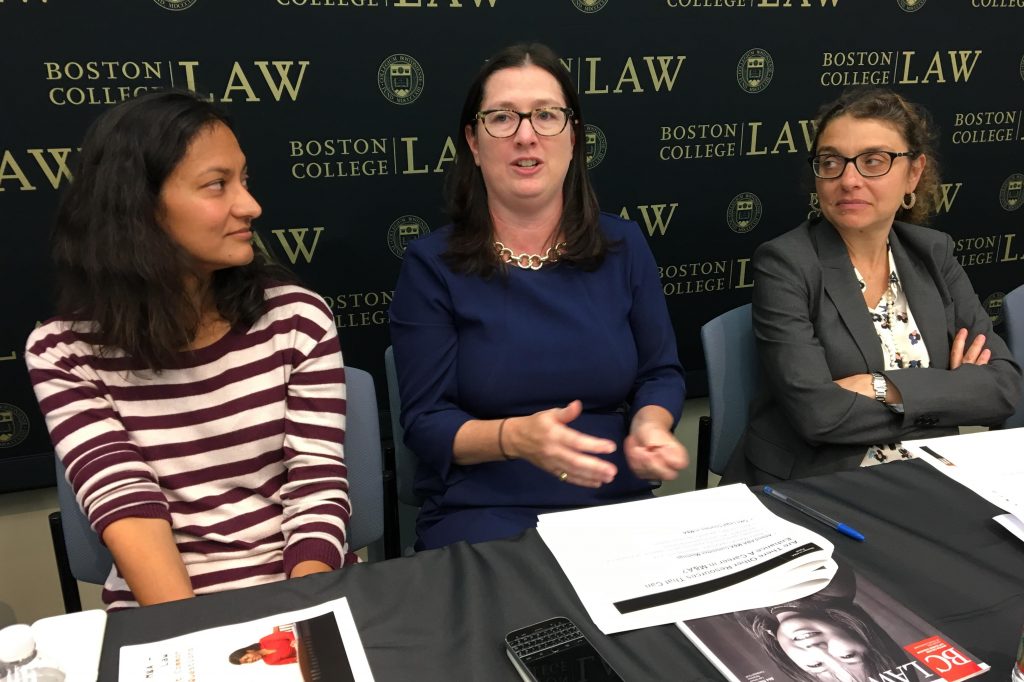The question is not so much why are there so few women lawyers in mergers and acquisitions as it is whether they know what they are missing. Six high-powered practitioners came to BC Law in September, PowerPoint and life stories in hand, and made their case for a career path that is not only professionally rewarding but also surprisingly flexible, absorbing, and, yes, to hear them tell it, even exciting.
During the presentation by the American Bar Association’s Women in M&A Task Force, they trotted out a recent survey that found that even though women comprise 50 percent of entry-level legal professionals, only 15 percent end up as senior equity partners in M&A practices. The panelists made their intentions clear: They are determined to get the numbers up by visiting law schools, talking to students, and offering themselves as role models.
Amanda McGrady Morrison, a partner at Ropes & Gray in Boston, chose M&A, she says, because she enjoys the finite time frame of a deal and being in the middle of the action. “I like the adventure, the excitement, and the feeling of being finished—like finishing your last exam in law school. Ahhh. Done.”
“It’s an exciting [there’s that word again] field in which to practice,” says Elena Norman, an M&A litigator with Young Conaway Stargatt & Taylor in Delaware, who thrives on the immediacy of the transaction taking place. “You’re not litigating about damages in the past. This is about companies that are enfolding as you’re working on them.”
Few of the panelists even considered M&A as a career. Some had little interest in or experience with finance as undergraduates or during law school.
Priya Howell of Morgan, Lewis & Bockius, who had studied finance, was the exception. But even she was seeking career direction as a new lawyer when she discovered the thrill of M&A. “It’s an adrenalin rush getting things done,” she says. “It felt like a really cool thing to get involved in.” Another plus for her is that this practice provides a window into all the other aspects of how business works.
For her part, Laura Knoll, a partner at Skadden, Arps, Slate, Meagher & Flom in Boston, was drawn to the field, she says, “because I was interested in hands-on experience that ends in something concrete,” in other words, a merger.
Rita O’Neill ’94, who loved “everything related to appellate advocacy” as a BC Law student, thought that would be her destiny until her first work assignment, an M&A case involving New York real estate. She liked everything about it: the teamwork, the drafting, the negotiating. It suited her. “I don’t have the attention span to go through a case that takes eight years, but I’m passionate about the opportunity to do deals in M&A,” says O’Neill, a partner at Sullivan & Cromwell in Los Angeles.
The panelists also talked of how, because of the peaks and valleys in an M&A practice, it’s possible to achieve work-life balance, something that benefits both men and women across the legal profession. “Some male associates with kids also want to be home with them,” O’Neill observes.
As a result of such trends, Howell adds, firms are becoming increasingly open-minded about flexibility. She, for example, is able to arrange her schedule so she can take summers off with her children. “Twelve years later and I’m still doing M&A, and I still love it,” she says.
Photograph: From left, Priya Howell, Rita O’Neill ’04, and Elena Norman were among the five-person panel on M&A moderated by Jennifer Muller.


